Sambal Matah is a deliciously piquant shallot sambal or salsa from Bali, Indonesia, with beautiful citrusy and umami notes. The former from both the lime juice and the lemongrass.
Estimated reading time: 6 minutes
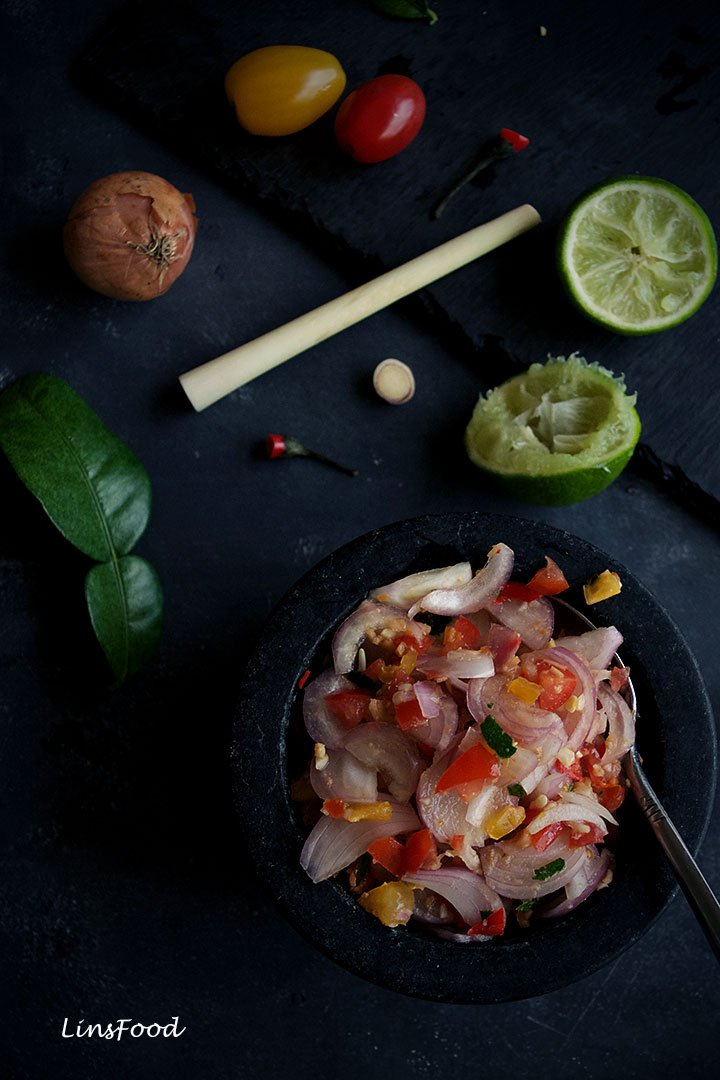
What does Sambal Matah mean?
There is no direct translation of the Malay/Indonesian word sambal. It usually refers to spicy condiments, both raw and cooked like Sambal Belacan and Sambal Ijo.
However, the term can also refer to mains and sides like Prawn Sambal and Sambal Goreng (a spicy stir fry, recipe soon!).
- Sambal = a spicy condiment, chilli dish
- Belacan = shrimp paste (terasi in Indonesian, kapi in Thai)
- Ijo = green, in Indonesian
- Goreng = fried or to fry, in Malay and Indonesian
- Matah = is a Balinese word adapted from mentah, which means raw
So Sambal Matah means raw sambal.
It started life known as sambel bawang (onion/shallot sambal). But as it moved out of Bali and became more well known, the name gradually evolved into sambal matah, to differentiate it from the more common onion sambal already in existence.
It is raw and reminds me of the Mexican Pico de Gallo or Salsa Fresca. Not surprisingly, you will find it in many guises all over South East Asia.
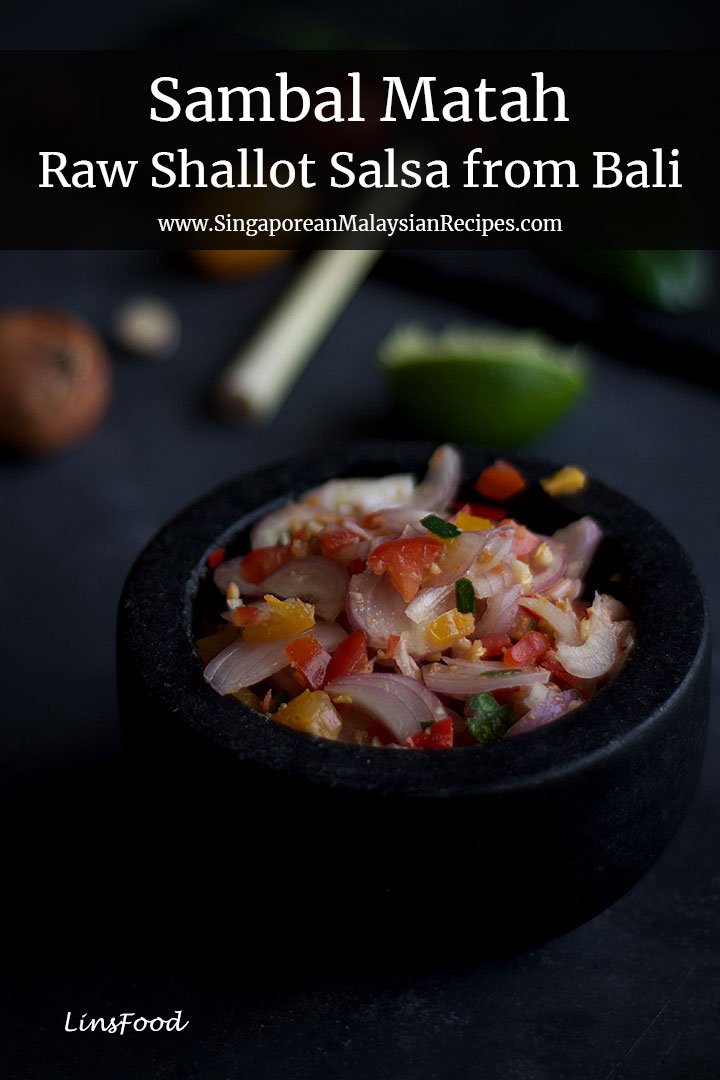
How to Serve this Sambal
Sambal Matah can be enjoyed in so many different ways.
- Pretty much how we would use any chilli condiment or salsa. Traditionally, this is popularly served with grilled fish or chicken. It goes amazingly with the crispy skin of both, providing a real contrast of flavours and textures.
- I pretty much have it as I would any other sambal, a little of it with every mouthful of rice or meat, whatever I happen to be eating. That’s how we eat sambals and nam priks in South East Asia! (nam priks are Thai chilli pastes/condiments/sauces). Quite often you’ll see me knocking this up in just about 5 minutes to add zing to a seemingly “dull” midweek meal.
- It is also perfect with satay – another grilled food, you see a theme, don’t you?
- And because I need spice in all foods, what better way to zing up my salad than by adding a tablespoon or two of this and tossing it all in.
Sambal Matah Ingredients
Shrimp Paste (Belacan)
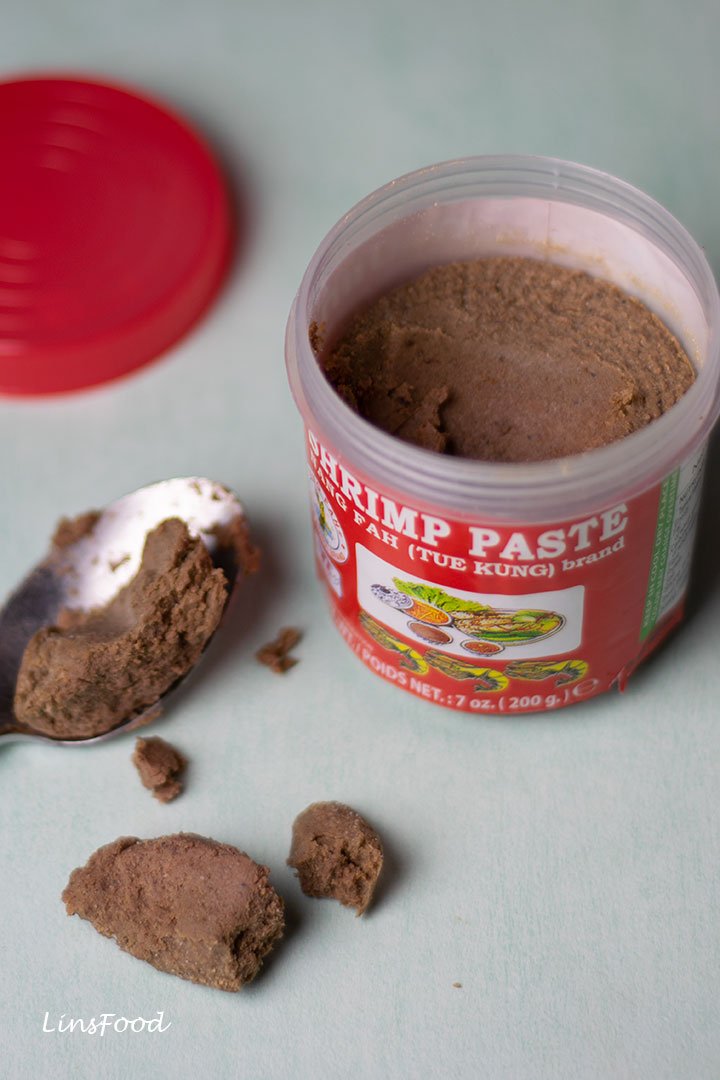
Click here to read more. This is probably the only pesky ingredient here. If you can’t get it easily, go online, folks, it’s such a light thing, p&p shouldn’t cost too much! We’ll be dry roasting the shrimp paste and basically just crumbling it up and mixing it in.
If you can’t get shrimp paste, you could use a couple of anchovies in oil or brine, patted dry, mashed up and used in its place. It won’t be the same flavour, but it will be delicious!
Failing that, just leave the shrimp paste out and you will still enjoy all the raw, pungent and citrusy notes of this sambal matah!
Lemongrass (Serai)
Maybe the other ingredient that could be a problem is lemongrass, although I think that it’s easier to come by. Leave it out if you can’t get it.
Kaffir Lime leaves
These are completely optional here, and if you don’t have access to them, the zest of a lime will do perfectly for the sweet, citrusy aroma.
Oil in Sambal Matah
Many years ago, on a dive trip around Bali, I had sambal matah with coconut oil added. This was the first time I had it in Bali itself. I was reliably informed by the old lady who made it that coconut oil is the traditional oil used in it.
On subsequent trips to Bali, I found that not everyone used coconut oil. Some went for just plain vegetable oil, which was a bit pointless, as it didn’t contribute any flavour, just calories!
I have a confession to make: While I enjoy coconut oil, I am not a fan of sambal matah with it. Coconut oil is so overpowering, I felt that it masked the citrusy notes of the lime juice and the lemongrass, which I just love.
So I don’t use any oil in my sambal matah, makes it much healthier too, right? I’ve given it as optional in the recipe.
Torch Ginger Flower in Sambal Matah
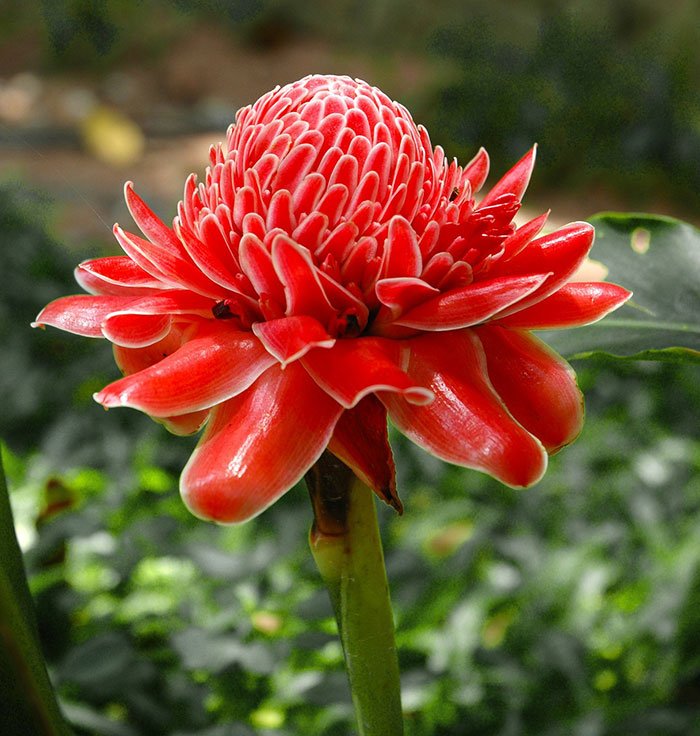
On a few occasions, in Indonesia, I’ve had sambal matah with finely sliced torch ginger flower, a very common ingredient in some parts of South East Asia. It adds a sharp, pungent, citrusy and peppery flavour to the sambal. As I don’t have access to torch ginger flowers here in the UK, I don’t have an option.
The image above shows you the flower in full bloom. In the kitchen, the flower is usually used while still closed as a bud, and sliced thinly. It’s known as kecombrang in Bahasa Indonesia (Indonesian) and bunga kantan in Bahasa Malaysia (Malay).
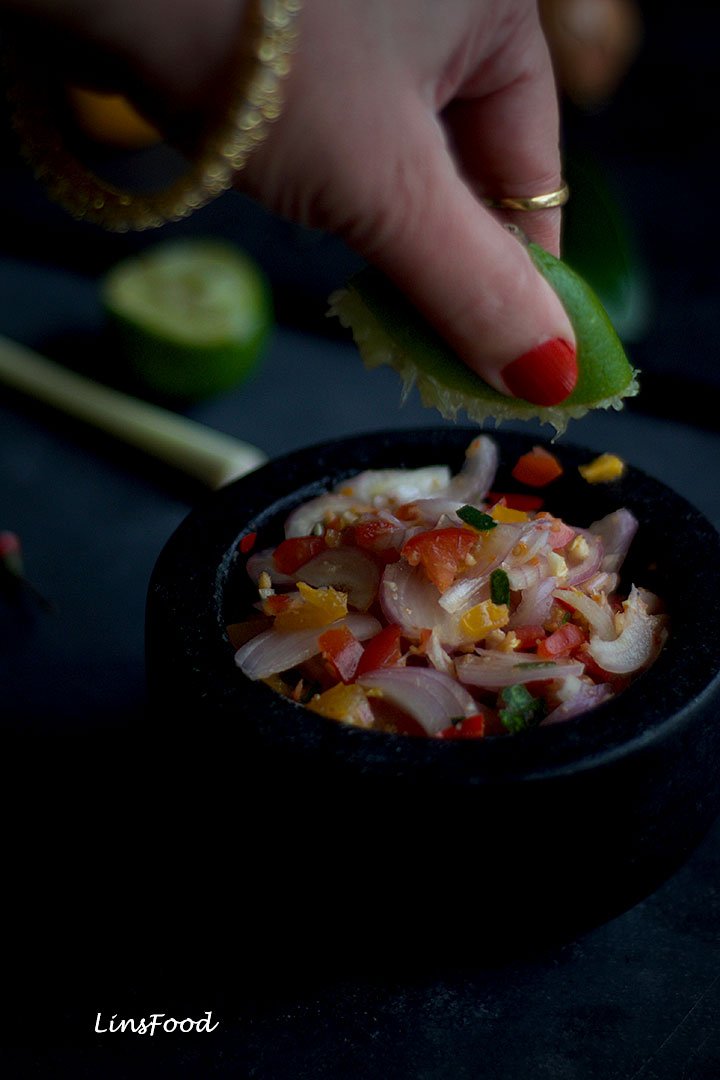
How long will Sambal Matah Last?
It will last 3 days in the fridge, covered. The shallots will take on a slightly pinky hue but will be perfectly fine and tasty still.
Quite often, I make a small amount, have half of it and just leave the rest in a bowl, cover with clingfilm and place it in the fridge until the next day or two.
Ok, then, let’s get to it!
♥ If you like the recipe, I would love to hear from you. And don’t forget that 5-star rating below! ? Thank you! ♥
If you make the recipe, share it on any platform and tag me @azlinbloor, and hashtag it #linsfood.
Lin xx
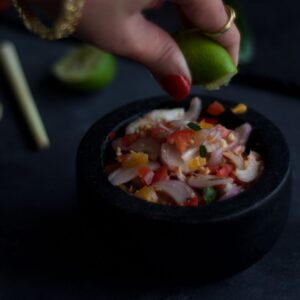
Sambal Matah, Indonesian Raw Spicy Salsa from Bali
Ingredients
- ½ tsp shrimp paste
- 4 shallots
- 4 red bird’s eye chillies
- 1 small clove garlic
- 1 lemongrass bottom half
- 1 tomato
- 1 tsp coconut oil (up to you if you want to add this)
- ¼ tsp salt
- ½ tsp sugar
- 1 Tbsp lime juice
- zest of 1 lime
Instructions
- Place the shrimp paste in a small frying pan over medium-low heat and dry fry for about 3 minutes, turning a couple of times, and flattening.
- While the shrimp paste is toasting, let’s get all the ingredients ready. Start by halving, then slicing the shallots fairly finely.
- Chop up the chillies and garlic finely.
- Slice the lemongrass very thinly.
- Chop up the tomato into small pieces, reserving the any juice.
- Place the toasted shrimp paste, the coconut oil if using, the salt, sugar and lime juice in a medium-sized bowl and with the back of a spoon, mash up the shrimp paste and mix everything up until you have a paste.
- Add all the aromatics and vegetables, (including the juice from the chopped tomato) that you’ve chopped into the bowl and toss everything well, making sure that all the chopped ingredients are coated with the shrimp paste and lime juice sauce. Serve as suggested above.

If one happened to be in Singapore, would it be possible to find this and other Sambal to try? I really enjoyed Sambal Matah while in Indonesia but it seems impossible to find in Japan. But while in Singapore I’d love if I could find it…
Hi Eric, sambal matah may not be the easiest to find in Singapore. I did a quick Google search for Indonesian restaurants in Singapore and checked out their menus. The only sambal on offer is sambal belacan, which is found everywhere.
To enjoy sambal, head to any hawker centre (indoors or out). You’d definitely find the standard sambal belacan at the Malay food stalls, most likely on the side like mayo and ketchup.
But if you were to order noodles, you’d most likely be served them with a dollop of some random sambal too, depending on what you’re having, whatever the stall.
What you will also find are vegetable dishes that have been prepared with sambal as a base. These could be a cucumber salad, or a pineapple one.
And then of course, there are the various wet, side dishes that are also called sambal: prawn sambal, fish sambal, egg sambal.
Sambal can refer to a condiment or a side dish, and generally is spicy. There is a dish called sambal goreng, that’s not actually a sambal in the strict sense of the word, but a stir-fried vegetable dish. This would be found at Malay food stalls that sell rice and various side dishes.
I hope that helps.
Hello!
Just a little note, we don’t use belacan or terasi in our sambal matah, our basic ingredients are just bawang merah (shallots), kaffir lime leaves (shredded thin), small chilli, lemongrass, and a must coconut oil (some will heat the oil before pouring to the mixture). There’s no garlic, and you can skip kecombrang too, if you add it the name becomes sambal bongkot as it will overpower the lemongrass. Cheers! 🙂
Hi there, thanks for your input, always good to know how your family or your area makes it. As mentioned in my post, you can definitely skip the flower, and I’ve eaten so much sambal matah that wasn’t made with coconut oil. Sambal matah and even sambal bongkot in Jakarta is going to be different than the one made in Denpasar or Medan or Surabaya. Recipes travel from family to family and area to area. And when they do, they do change slightly. But I appreciate you taking the time to leave me a comment.🙂
Actually, I have to agree with Azlin. This is exactly how my mami used to make sambal matah. I grew up in Bali where it comes from, and we didn’t really like coconut oil in ours too.
Thanks for letting us know, Siti. I love hearing how certain dishes are different, yet the same.
This was a big hit during our grilling party on the 4th. Everyone was asking for the recipe. Thank you!
Awesome, I’m pleased everyone loved it!
Sambal matah sounds so very flavorful, so beautiful and so very tasty. I am definitely going to make the sambal with our lunch tomorrow. I have all the ingredients. Yummy.
Thank you, it’s an amazing condiment.
Our simpler kachumbar salad is somewhat like this but Sambal Matah sounds like a lot more fun as it has a so many layers from sweet, sour, salty and umami flavours. That ginger flower is so gorgeous! Thanks for sharing the picture and all the very interesting information.
Thank you, yes, the shrimp paste and lemongrass really shine in this.
Have had the opportunity to taste Sambal Matah and that too without the shrimp paste at a vegan restaurant in Ubud. Tastes so much like salsa or what we call in the local language in Kenya, kachumbari. Only difference is the addition of lemongrass and the bird’s eye chilli which imparts a distinct hotness. Also had the opportunity to see those beautiful torch ginger flowers.
That’s awesome, yes, I’m a huge fan of kachumbar.
This was utterly delicious! We decided to have a barbecue today in the cold, and I remembered this recipe from your chili series. Went so well with everything! I don’t know what it was, the lemongrass maybe? Just kept coming through with each bite. And so easy to make, I made a second batch! Thank you Azlin.
I’m so pleased to hear that, Emma, it’s definitely a favourite of mine. The fact that you made it twice on the same day is a great testament! That flavour that keeps coming thorough, yep, you’re totally right, it’s the sharp, citrusy lemongrass.